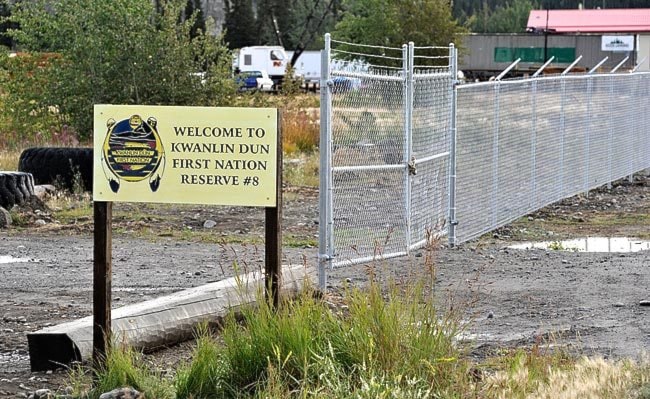Land leasing is rare in the territory, but not unheard of.
There have been at least two lease agreements signed in the Yukon, and by the end of the year there could be a lot more.
The Kwanlin Dun First Nation is putting as many as 276 lots (and a condo development) into the land inventory.
But they are not for sale, just for lease.
So far, only the Teslin Tlingit Council and the Carcross/Tagish First Nation have issued such lease agreements. But they were solely for First Nation citizens.
Many of the new lease lots will be available to everyone.
The important thing is for buyers to read the lease and make sure their interests are protected, said Susan Zanders, owner of Verico Zanders & Associates Mortgage Brokers Inc. She grew up in Whitehorse and handled a lease for a Carcross/Tagish First Nation citizen in 2007.
An agreement for the first five available Kwanlin Dun lots, located on Grove Street, Walnut Crescent and Pine Street in Porter Creek, is being chosen from a collection suggested by the Canadian Mortgage and Housing Corporation, said acting chief Ray Sydney.
The First Nation will offer 35-year leases, he said.
“That satisfies CMHC because that goes 10 years over the value of the mortgage payments of the home, usually.”
Whenever the leaseholder wants to sell the home, the agreement resets to zero, Sydney added.
“And the lease agreements never end, it just gets renewed, so it’s secured. It’s their home, and they sit on that land and just renew their lease agreements.”
“Thirty-five years is not a long lease,” said Zanders, adding an automatic renewal is a condition that must be included in the agreement.
“I haven’t seen really short leases like that. The length of time seems really short to me.”
The shorter the lease, the more possibility for problems and the shorter the mortgage, she said.
And that drives up mortgage payments.
With no land in the mix, it seems cheaper initially, but there are lease payments added to the mortgage payment, said Zanders.
“You never own that land, it’s owned by someone else, you’re just paying to use it, to have your house on it,” she said.
These annual, lease payments can be as low as two to three per cent of the lot’s assessed value, but nothing’s been decided, said Sydney.
“That’s normal in Canada, but it’s not chiseled in stone,” said Sydney. “Every five years it will be up for renewal. And it will be adjusted accordingly.”
And buyers should remember the lease fee is based on the land’s assessed value - not the home. While houses can depreciate, the value of land tends to appreciate over time, said Zanders.
“But real estate is really quite unique in that the value, or the price, is based strictly on supply and demand,” said Whitehorse-based appraiser Jim Yamada.
And when it comes to home ownership, the biggest barrier is always financing, he added.
So leasing, because it seems cheaper, may be attractive.
But it’s not always less expensive.
“Banks, generally, don’t mortgage properties that are leased,” said Yamada.
There are exceptions, like loans issued against personal property, like a mobile home, he added.
But the security of the investment is still up for debate. For example, would the lease allow you to move the house off the land when the lease is sold or expired?
It’s often too expensive to do that anyway, said Zanders.
And what conditions could have a leaseholder kicked off the lot, like environmental problems or general degradation of the land?
There will be regular monitoring, especially for things like pollution, said Kwanlin Dun technical staff.
But many other details haven’t been worked out yet.
Knowing that Kwanlin Dun is in talks with the national mortgage and housing corporation is a relief, said Zanders.
Few mortgage brokers can deal with lease agreements, and fewer would handle them if not approved by the CMHC, she said.
But the national corporation’s approval doesn’t guarantee it’s a good arrangement, she added.
“Leasing is not a first choice just because of security,” said Zanders.
No one can really know what will happen with the Kwanlin Dun’s leasing arrangements until one is struck, she said.
“It will be a trial run,” she said. “It’s going to be very interesting.”
And by issuing leases to the public, Kwanlin Dun is setting precedent in the territory.
It has identified the potential for 85 more lots in McIntyre, another 185 lots beside that, a condo development in Valleyview, one lot downtown on Jarvis Street and five in Porter Creek.
The First Nation’s construction company, Canyon City Construction, will sign the leases, as a developer, to build homes on the first five, single-family lots in Porter Creek.
The foundations are expected to be poured before the snow flies, said Sydney.
But the First Nation is not planning any more beyond that, he said.
“To build a family home at this point and time, if you talk to contractors, they say roughly $225 a square foot,” said Sydney.
The person holding the lease should be able to tailor the size of home to their own financial situation.
The lease will require the house be built on the land within two years, he said.
The First Nation wants well-designed homes, comparable to those around them, in healthy communities, said Kwanlin Dun officials.
And according to city staff, most of the remaining developable land in town is owned between Kwanlin Dun and the Ta’an Kwach’an Council.
It puts Kwanlin Dun in a good situation. Its final agreements with Ottawa stipulate it gets most of the income tax collected from people living on its land.
The question is whether the deal will be sweet enough to get people to sign on.
Contact Roxanne Stasyszyn at
roxannes@yukon-news.com
